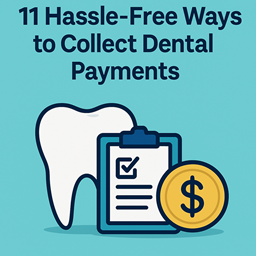Every hour you spend chasing down overdue patient bills is an hour taken away from patient care and growing your practice. We understand how frustrating it is to provide quality care and then not get paid. Using a dental-focused collection agency means you get paid what you’re owed while protecting your patient relationships – so you can focus on dentistry, not debt.
In fact, some dental specialists like orthodontists or oral surgeons often have long treatment plans or high-cost procedures, making non-payment a serious risk. Rather than writing off thousands in unpaid Invisalign or surgery fees, partner with experts who specialize in dental collections. A collection agency can handle the tough conversations to ensure you get paid without you having to become the ‘bad guy’ with your patients.
Need a Dental Collection Agency? Contact UsServing hundreds of dentists nationwide – HIPAA compliant. We can do both First Party and Third Party Collections! |
If you’re tired of chasing overdue balances, these 11 strategies will help you recover unpaid bills—without turning into the “bad guy.”
1. Set Clear Payment Expectations from the Start
Preventing unpaid bills begins before a patient ever walks through your door. Have a clear financial policy detailing when and how payments are expected. Consider:
-
Sharing policies on your website so new patients see them upfront.
-
Providing written copies during the initial consultation or appointment scheduling.
-
Discussing potential out-of-pocket costs before treatment starts.
When expectations are outlined from day one, patients are more likely to pay on time or communicate if they’re having difficulty.
2. Offer Flexible Payment Options
A single payment method can deter some patients from settling their balances. Offering a range of payment options shows you’re accommodating and can increase the likelihood of timely payment:
-
Credit cards (Visa, MasterCard, etc.)
-
Payment plans for high-cost treatments (orthodontic work, oral surgery)
-
Online payment portals (convenient, 24/7 access)
The easier it is for patients to pay, the better your chances of collecting.
3. Implement Automated Billing Reminders
Your team should not spend endless hours sending out manual reminders. Leverage automated billing systems or patient management software that:
-
Sends text or email alerts prior to a due date.
-
Flags overdue accounts and schedules follow-up reminders.
-
Provides an online link or instructions so patients can make immediate payments.
This consistent, automated communication keeps patients informed and minimizes any claims that they “didn’t know” payment was due.
4. Train Your Front-Office Staff in Collections Etiquette
Your staff is often the first line of defense when it comes to patient billing questions or overdue balances. Equip them with:
-
A polite but firm script for payment requests.
-
Guidance on how to handle sensitive conversations around overdue bills.
-
Clear escalation protocols (e.g., after 30 days late, forward to the office manager).
When the staff is trained to handle these issues professionally and confidently, it reassures patients while also emphasizing your practice’s payment standards.
5. Use a Tiered Follow-Up System
Not every overdue balance requires a jump straight to collections. A tiered follow-up approach can help you recover many unpaid bills in-house:
-
Send a friendly reminder email or text after a missed due date.
-
Place a polite phone call a week later if there’s no response.
-
Send a written notice or letter outlining potential consequences if the bill remains unpaid.
If the patient still does not respond or agree to a payment plan, you can move the account to a more formal collection process.
6. Maintain Patient Relationships with a Gentle Tone
Dentists and orthodontists often worry about damaging patient relationships by sending accounts to collections. However, a gentle yet consistent tone can maintain good rapport:
-
Focus on understanding the patient’s situation rather than immediately demanding payment.
-
Offer to discuss payment plan options that won’t cause undue financial stress.
-
Reassure them that your primary goal is to help them fulfill their financial obligations in a reasonable manner.
This approach shows empathy while still emphasizing that the balance must be resolved.
7. Leverage Insurance Coordination
Sometimes, unpaid bills result from insurance confusion—a patient may not realize a portion of the cost is not covered. Streamline your insurance processes to reduce confusion and expedite payments:
-
Verify coverage before procedures.
-
Submit claims promptly and follow up on denials.
-
Communicate proactively if there’s a partial payment and the patient is responsible for the difference.
Well-organized insurance coordination can help you collect more efficiently and minimize misunderstanding.
8. Stay on Top of Aging Receivables
Busy practices can lose sight of overdue balances that slip further and further behind. Assign a staff member (or team) to regularly run aging receivables reports:
-
Track 30-day, 60-day, 90-day outstanding bills so you know where to focus.
-
Reach out earlier rather than letting unpaid bills sit.
-
Set specific goals (e.g., reduce 90-day receivables by 50% over the next quarter).
The longer a bill remains unpaid, the less likely it is to be recovered—so timely follow-ups matter.
9. Partner with a Specialized Dental Collection Agency
When internal efforts fail, a professional collection agency can step in. They bring:
-
Expert negotiation skills to handle patient disputes and non-responses.
-
Legal options for more stubborn debts.
-
Credit bureau reporting to incentivize payment.
By handing off your hardest cases, you recover owed revenue while staying focused on patient care. An agency versed in dental or medical collections also understands HIPAA requirements, patient privacy concerns, and the importance of preserving your reputation.
10. Offer a Free Receivables Assessment
Many dental practices are unsure how much revenue they may be losing. A reputable agency often provides a free assessment of your receivables. They can:
-
Estimate how much overdue revenue you could realistically recover.
-
Suggest a tailored collection strategy based on your patient demographics and services.
-
Highlight common billing pitfalls so you can strengthen your internal processes.
This no-obligation review can reveal surprising amounts of recoverable funds, making it a win-win for busy dentists and practice managers.
11. Enforce a No-Fee-Unless-You-Collect Model
Dentists sometimes avoid collection agencies because they fear hefty upfront costs or high retainer fees. Fortunately, many agencies charge only when they successfully collect. This contingency model:
-
Removes financial risk for your practice.
-
Ensures the agency works diligently to recover payments (their compensation depends on it).
-
Simplifies budgeting, since you pay a percentage of only what is actually collected.
By choosing an agency with a no-recovery, no-fee approach, you can pursue overdue balances without worrying about sunk costs.
Conclusion: Don’t Let Unpaid Bills Erode Your Bottom Line
Unpaid patient bills are more than a nuisance—they directly impact your dental practice’s profitability and growth. By combining proactive billing policies, clear communication, and a trusted dental collection partner, you can recover more of what you’ve already earned—without tying up your staff in stressful payment chases.
Ready to Recover Your Unpaid Bills?
Contact our dental collection specialists today for a free consultation and learn how we help practices like yours reclaim thousands in overdue accounts—while preserving patient relationships.
Focus on Patient Care, Not Debt Collection—Start Recovering What You’re Owed Today!



